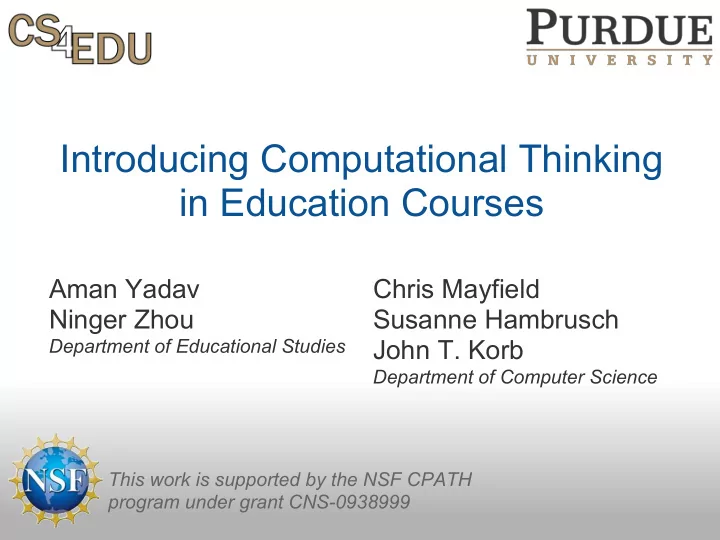

Introducing Computational Thinking in Education Courses Aman Yadav Chris Mayfield Ninger Zhou Susanne Hambrusch Department of Educational Studies John T. Korb Department of Computer Science This work is supported by the NSF CPATH program under grant CNS-0938999
Project CS4EDU http://cs4edu.cs.purdue.edu/ Goal Create new pathways for undergraduate education majors to become computationally educated secondary teachers Highlights CS teaching endorsement (supplemental licensure) Computational thinking module (and WebQuest) New Courses Contemporary Issues in Computing Methods of Teaching Computer Science
Overview Short Term Goal Prepare future educators to present their subject areas using ideas from computational thinking Long Term Goal K-12 students will have greater exposure to computing in general Our Approach Develop a one-week module on CT (what & how) Embed CT in required courses for education majors Survey the students before/after taking the module
CT Pop Quiz Which of the following is NOT like the others? [A] People standing in line at the store [B] List of print jobs waiting to be printed [C] Set of tennis balls in their container [D] Vehicles lined up behind a toll booth [E] Patients waiting to see the doctor
CT Pop Quiz - Answers Which of the following is NOT like the others? [A] People standing in line at the store (queue) [B] List of print jobs waiting to be printed (queue) [C] Set of tennis balls in their container (stack) [D] Vehicles lined up behind a toll booth (queue) [E] Patients waiting to see the doctor (queue)
Student Responses - Queues vs Stack Why students picked the tennis balls: "...were not waiting to go anywhere." "...had nothing to do with people." "...were not moving towards a goal." Primary Secondary
CT Module Overview Concepts from CT that we presented to the students
What is Computational Thinking? Definition “CT involves solving problems, designing systems, and understanding human behavior, by drawing on the concepts fundamental to computer science.” Vision A fundamental skill used by everyone by the middle of the 21st century (i.e., like reading, writing, and arithmetic). J.M. Wing, “Computational Thinking,” CACM viewpoint, vol. 49 no. 3, March 2006, pp. 33-35.
Overview of Lecture 1 Focus: What is CT? CT in daily life Driving directions Buying movie tickets Abstraction & logical thinking Recall "queues vs stack" Inductive/Deductive reasoning Algorithms and debugging PB&J sandwich activity
Another Example Which of the following is NOT like the others? [A] Files and directories on a hard disk [B] Parents and children in a pedigree chart [C] Brackets in the NCAA basketball tournament [D] My closest friends on Facebook / Twitter [E] The format of XML or PDF documents
Answers Which of the following is NOT like the others? [A] Files and directories on a hard disk (tree) [B] Parents and children in a pedigree chart (tree) [C] Brackets in the NCAA basketball tournament (tree) [D] My closest friends on Facebook / Twitter (graph) [E] The format of XML or PDF documents (tree)
Student Responses - Trees vs Graph Some of the confusion: [C] "Brackets branching inward instead of outward." [E] "All others are linked to you; PDFs are not linked." [E] "Everything else branches; PDFs not able to branch." Primary Secondary
Overview of Lecture 2 Focus: Teaching CT in K-12 Connections to educational theory Algorithms vs heuristics Ideas for presenting algorithms Towers of Hanoi role play Using technology to motivate CT Facebook constellation Online resources (new in 2011) CSTA, ACM, CS Ed Week CS Unplugged, CS4FN Google's CT repository
Attitude Survey Results
Research Study How does knowledge of CT affect one's attitude toward CS? Pre-Post Design Sent survey to 155 education majors 100 responded (64.5% return rate) 78 females; 22 males 55 elementary; 45 secondary Survey Contents 16 Likert-scale (adapted from Hoegh & Moskal, 2009) 4 free response (e.g., What is CT? How does it relate?) See the paper for details!
Participants’ View of CT Sample Student Responses A1: Computational thinking involves problem solving with algorithms and logic . A2: Knowing how to use computers for problem solving. A3: It is being able to solve problems in a new way, sometimes like a computer. A4: Thinking above and beyond what normally comes to mind.
Participants’ View of Computing Sample Student Responses A1: Computing is the use of computers or some other form of technology to solve a problem. A2: Computing is the science of solving a problem using some pre-set method that has been established. A3: Being able to use and apply computer skills to daily life.
Integrating CT into the Classroom Sample Student Responses A1: In the linguistic sense, we can teach students how language is inherently computational, especially in regards to syntax and morphology. A2: Using programs that allow students to learn more about computers. A3: Make it standard in every class.
Lessons Learned
CT Module "Version 2.1" Module changes Focused more on how CT can be integrated in core content areas Facilitating understanding of CT through additional concrete examples Clicker questions to foster discussion of CT concepts Removed concepts that didn't work e.g. "Towers of Hanoi" demonstration for recursion WebQuest - online version of module Quasi-experimental study
Future & Ongoing Work CS Teaching Endorsement CS Teaching Methods Course to provide students with pedagogical and content knowledge and experiences to be effective computer science teachers in high school. 2011 workshop about: raising awareness of the CS Principles efforts sharing experiences of challenges and opportunities creating new synergies between computer science faculty, education faculty, and high school teachers
Summary Approach Presenting computational thinking to all education majors Results Attitudes toward computer science become more favorable Increased interest in teaching general computing principles See the paper for: Other ideas for module content Additional discussion of results List of post-survey questions CT lecture slides: http://cs4edu.cs.purdue.edu/comp_think
Recommend
More recommend